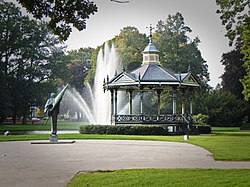|
Apeldoorn
 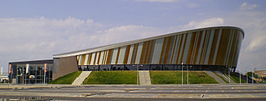 Apeldoorn (Dutch pronunciation: [ˈaːpəldoːr(ə)n] ⓘ; Dutch Low Saxon: Apeldoorne) is a municipality and city in the province of Gelderland in the centre of the Netherlands. The municipality of Apeldoorn, including the of villages of Beekbergen, Loenen, Ugchelen and Hoenderloo, had a population of 165,525 on 1 December 2021. The western half of the municipality lies on the Veluwe ridge, with the eastern half in the IJssel valley. The city of Apeldoorn    The oldest known reference to Apeldoorn, then called Appoldro, dates from the 8th century. The settlement came into being at the point where the old road from Amersfoort to Deventer crossed that from Arnhem to Zwolle. A 1740 map refers to it as Appeldoorn.[5] Close by is the favourite country-seat of the royal family of the Netherlands called the palace het Nieuwe Loo (now Het Loo). It was originally a hunting lodge of the dukes of Gelderland, but in its present form dates chiefly from the time of the then Stadtholder William III of England (1685–1686).[5][6] The younger sister of Princess Beatrix, Princess Margriet, lives nearby the palace Het Loo, with her husband Pieter van Vollenhoven. Apeldoorn was a relatively insignificant place until the major building projects of the 19th century and those of the period following World War II.[5] The Protestant church was restored after a fire in 1890.[6] The Roman Catholic Mariakerk is a national monument. Apeldoorn possesses large paper-mills, many offices (Centraal Beheer, an insurance company; the Dutch Tax services; the "Kadaster", the government land registry service; and some more), a hospital and nursing homes. With over 100,000 people working in the municipality, Apeldoorn is one of the most important employment centres in the eastern Netherlands. Apeldoorn also has several important educational institutes, such as the Saxion University of Applied Sciences (hotel and facility management), the Wittenborg University of Applied Sciences, the Netherlands Police Academy and the Theological University of Apeldoorn. 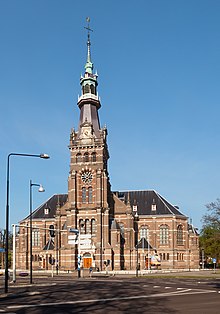 Apeldoorn is well suited to logistical and distribution companies because of its location close to the intersection of two major Dutch motorways. The A1 runs west from Amsterdam to the German border, where it leads towards Hannover, and Berlin. The A50 connects the north of the Netherlands with the south. Apeldoorn used to be[when?] well known as a town of paper making and clothes washing companies, due to the clean filtered groundwater which seeped through the sand of push moraines down to the IJsselvallei east of Apeldoorn. In 2008 the largest paper mill of what was left of "Van Gelder Papier" after reorganizations went bankrupt. In 1996 a devastating fire destroyed the remnants of the last part of the original factory. Other parts of the production facility that remained are now in use as a production facility by AFP (Apeldoorn Flexible Packaging B.V.), since early 2021 known as "Trioworld" because AFP merged with "Trioplast", Loparex B.V. and Owens Corning Veil Netherlands B.V. On the entire industrial estate now known as "Van Gelder Park" are now also located a local head office of Rabobank, the main police and fire department offices along with some other local companies. Apeldoorn has a considerable meat processing industry with production and storage facilities of among others; Vion NV, Van Drie Group (ESA, Ekro), Grolleman Groep (cold stores, transport and meat processing), Amsterdam Meat Company (Ameco). Other big/larger companies or ones that are of local importance include Hanos international (horesca), Hamer B.V. (installation), HSL Logistics (since merged with GVT Logistics), HCA Holland Colours (industrial plastics coloring), Remeha (heating boilers), Royal Reesink N.V. The former distribution centre is now used as a distribution centre for Picnic, an internet grocery home delivery service, although Royal Reesink is still using the office parts of the building. In August 2018 PostNL opened a large package sorting centre at the Oude Apeldoornseweg, newly built at the industrial area now known as "FizzionParc" but once was known as an industrial estate of Philips Data Systems, the new PostNL location will provide work for around 400 employees. On 27 November 2018, a rapid spreading fire completely destroyed the largest store of "Karwei" DIY centres in The Netherlands, located at the Laan van de Dierenriem in Apeldoorn. No one was injured, and as of 2020 the location was rebuilt and reopened. A part of the new building is now up for rent for another business. Akzo Diosynth once operated a facility that produced base materials for medicine manufacture, but production has since ceased. The terrain located at the Vlijtseweg has been renamed after the product that was produced here before that, Zwitsal. It is now known as "Zwitsal Apeldoorn" and the former facility now houses many new local businesses, such as the beer brewery "De Vlijt". Apenheul is a zoo which hosts a number of different types of apes and monkeys, many of which are free to walk around the visitors. It is situated at the western edge of Apeldoorn and can easily be reached by local bus. There is also an amusement park situated in Apeldoorn, called the Koningin Juliana Toren (Queen Juliana Tower). It is situated nearby the Apenheul and lies on the road to Hoog Soeren. It is called the Koningin Juliana Toren because of the tower, which was built in 1910 and was later named after Queen Juliana. The local hospital is the Gelre Hospital "Lukas", offering secondary health care to Apeldoorn and the surrounding towns. Apeldoorn railway station is, among regular national and international services, the terminus for the Veluwse Stoomtrein Maatschappij, a preserved steam railway that runs to Dieren via Beekbergen. In April 2009 Apeldoorn made world news, when eight people were killed after a man tried to attack the Dutch royal family during a Queen's Day celebration by crashing his car near the royal family's bus. The southwestern corner of the municipality is part of the Hoge Veluwe National Park. It is the final Battle Honour of The Royal Canadian Regiment who took part in the town's liberation in World War II. House of Orange-NassauPaleis Het Loo reflects the historical ties between the House of Orange-Nassau and the Netherlands. The central part of the palace and the lateral pavilions show how the palace was inhabited by the House of Orange for three centuries starting with the King Stadtholder William III of England up to and including Queen Wilhelmina. In November 1684 Prince William III of Orange, then Stadtholder of Gelderland, purchased Het Loo with the intentions of building a palatial hunting lodge somewhere on the property. On 5 April 1685, the first contract was tendered and in September of the same year the stonework of the middle section (or corps de logis) of what came to be known as Het Loo was completed. In 1686, the year given on the facade of the building, the wings, originally linked by colonnades to the corps de logis were added, the walls were built and the gardens were laid out. Het Loo became the favorite hunting seat and country palace of William III and his wife Princess Mary II, and until his death in 1702 furnishings and decorations both inside and outside underwent repeated alterations and embellishments. At that time symmetry was considered ideal and the design for the building and grounds featured a central axis with mirror image components on either side. Inside the palace the axis consisted of the Entrance Hall, the Staircase and the Great Hall on the first floor. West and east of the Great Hall respectively were the apartments of William III and Mary II. The apartments of the courtiers and the Dining Room were on the ground floor. In 1689 William III became King of England, Scotland and Ireland and this elevation of his position and power brought an enlargement of Het Loo in its wake. Between 1691 and 1694 the colonnades which linked the corps de logis to the wings on either side were replaced by four pavilions. These pavilions contained the new apartments of William III and Mary II, a new Dining Room, a Long Gallery and a Chapel. Queen Mary did not return to the Netherlands after 1689 and never saw the enlargement. On the death of King William III in 1702 there was disagreement about his inheritance, but eventually, in 1732, Het Loo descended to Willem IV (1711–1751) who was, from 1747, Stadtholder of all the provinces. Both Willem IV and his son Willem V (1748–1806) used the palace in the 18th century as a summer residence. DemographicsAs of 2020, Apeldoorn had a total population of 163,818 people.[7] Inhabitants by origin
GeographyClimateApeldoorn experiences an oceanic climate (Köppen climate classification Cfb) similar to almost all of the Netherlands. 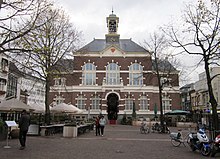 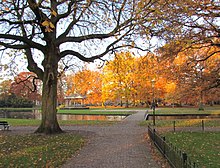  Population centres Very small hamlets are printed in italics.
Economy and infrastructureLocal businesses
Public transportThere are four railway stations in Apeldoorn, these are:
The bus services in the city are provided by Keolis and has 18 lines.
CultureMuseums  
Theater / cinema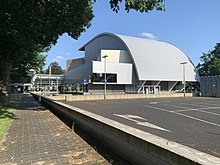
Education
SchoolsWikimedia Commons has media related to Category:Schools in Apeldorn. UniversitiesSportUntil early 2013, Apeldoorn housed the professional football club AGOVV Apeldoorn (Eerste Divisie), that played its matches in the Stadion Berg & Bos in the western part of Apeldoorn. However, AGOVV was forced to declare bankruptcy on 8 January 2013, because of an €400,000 tax debt. In 1958 the AGOVV stadium was used to promote Dutch Rugby Football, by staging a match between an English touring XV Thomas Cook's Rugby Club and RC Hilversum in front of 2,671 spectators. It was a 3 points draw. See film clip of first overseas tour to Holland 1958 [9] The present rugby club, Rams RFC, was founded in December 1971. The most successful club in Apeldoorn is the SV Dynamo volleyball team, who are the 15-fold champion in the Dutch A-League, most recently in 2023. Another successful volleyball club in Apeldoorn, and a big competitor to Dynamo, is Alterno. Because of the growth of Apeldoorn, and the population's interest in sports, Apeldoorn has built a new stadium for volleyball, indoor athletics and track cycling. The stadium, Omnisport Apeldoorn, opened in 2008 and has hosted the 2011 UCI Track Cycling World Championships and the European Track Championships in 2011 and 2013. In 2016 the city hosted the opening time-trial stage of the Giro d'Italia. Apeldoorn houses the following football clubs:
Notable people    Public servants
The arts
Sport
Business
2009 car attackOn 30 April 2009, the Dutch national holiday Koninginnedag (Queen's Day), a man drove his car at high speed into a parade which included Queen Beatrix and other members of the Royal family.[11] The driver hit members of the public lining the street leaving twenty-two injured and eight dead, including the driver himself, who died the following day. Although the Royal family was unharmed, it is believed to be the first attack on the Dutch royal family in modern times.[12] Twin towns – sister citiesApeldoorn is twinned with:[13]
ReferencesCitations
Sources
External linksWikimedia Commons has media related to Apeldoorn.
|
|||||||||||||||||||||||||||||||||||||||||||||||||||||||||||||||||||||||||||||||||||||||||||||||||||||
